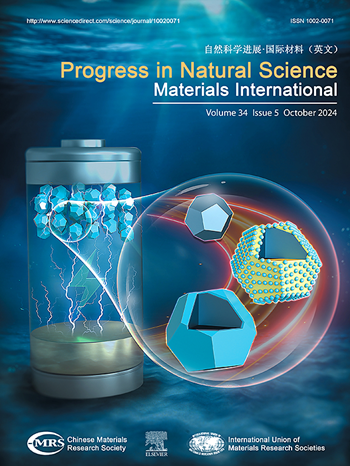Facile formation of Mg-containing interphase on nanosilicon from Agar/MgCO3 precursor for lithium-ion battery anodes
IF 7.1
2区 材料科学
Q2 MATERIALS SCIENCE, MULTIDISCIPLINARY
Progress in Natural Science: Materials International
Pub Date : 2025-02-01
DOI:10.1016/j.pnsc.2024.12.002
引用次数: 0
Abstract
The ultra-high theoretical capacity (4200 mAh g−1) of Silicon anode materials for lithium-ion batteries while which is one of the ideal replacement materials for graphite anodes. However, the poor electrical conductivity and greatly reduces the cycle life of the battery of Silicon material, which suffers from severe volume expansion during charge/discharge cycling leading to electrode pulverization. In this work, Agar/magnesium carbonate-coated silicon nanocomposites were synthesized by utilizing the "self-solidifying" property of agar. The magnesium oxide formed by the decomposition of magnesium carbonate at high temperatures mitigates the volume expansion of nanosilicon together with the derived carbon layer. Moreover, the lithium-magnesium alloy electron-conducting interface layer generated by the reaction between lithium ions and magnesium oxide, which greatly shortens the diffusion length of lithium ions and electrons inside the electrode during the charge-discharge cycle. The first discharge specific capacity was 2060.2 mAh g−1, the Coulombic efficiency as high as 86.28 %, and still possesses a reversible specific capacity of 801.5 mAh g−1 after cycling 200 cycles at a high current of 500 mA g−1 of Agar/magnesium@Si with optimal ratio composite. The composite material used in this work largely suppresses the volume expansion of the silicon anode and contributes to the design of low-cost and high Coulombic efficiency lithium-ion batteries.
锂离子电池阳极用琼脂/MgCO3前驱体在纳米硅上容易形成含镁间相
硅负极材料具有超高理论容量(4200 mAh g−1),是锂离子电池理想的石墨负极替代材料之一。但硅材料的导电性差,大大降低了电池的循环寿命,在充放电循环过程中体积膨胀严重,导致电极粉末化。本研究利用琼脂的“自固化”特性,合成了琼脂/碳酸镁包覆硅纳米复合材料。碳酸镁在高温下分解形成的氧化镁与衍生的碳层一起减轻了纳米硅的体积膨胀。此外,锂离子与氧化镁反应产生的锂镁合金电子导电界面层,大大缩短了充放电循环过程中锂离子和电子在电极内部的扩散长度。首次放电比容量为2060.2 mAh g−1,库仑效率高达86.28%,在琼脂/magnesium@Si的500 mA g−1大电流下循环200次后仍具有801.5 mAh g−1的可逆比容量。该复合材料在很大程度上抑制了硅阳极的体积膨胀,有助于设计低成本、高库仑效率的锂离子电池。
本文章由计算机程序翻译,如有差异,请以英文原文为准。
求助全文
约1分钟内获得全文
求助全文
来源期刊
CiteScore
8.60
自引率
2.10%
发文量
2812
审稿时长
49 days
期刊介绍:
Progress in Natural Science: Materials International provides scientists and engineers throughout the world with a central vehicle for the exchange and dissemination of basic theoretical studies and applied research of advanced materials. The emphasis is placed on original research, both analytical and experimental, which is of permanent interest to engineers and scientists, covering all aspects of new materials and technologies, such as, energy and environmental materials; advanced structural materials; advanced transportation materials, functional and electronic materials; nano-scale and amorphous materials; health and biological materials; materials modeling and simulation; materials characterization; and so on. The latest research achievements and innovative papers in basic theoretical studies and applied research of material science will be carefully selected and promptly reported. Thus, the aim of this Journal is to serve the global materials science and technology community with the latest research findings.
As a service to readers, an international bibliography of recent publications in advanced materials is published bimonthly.

 求助内容:
求助内容: 应助结果提醒方式:
应助结果提醒方式:


